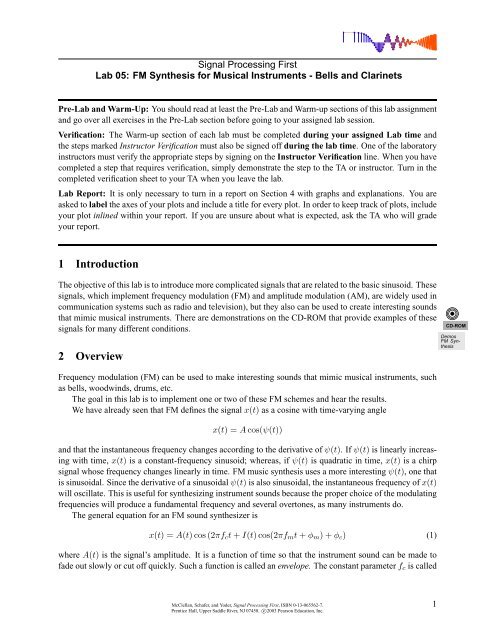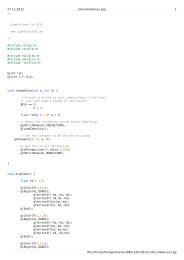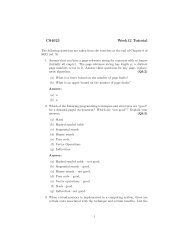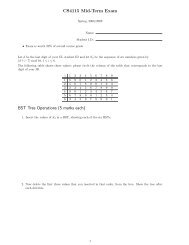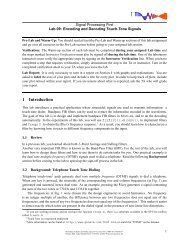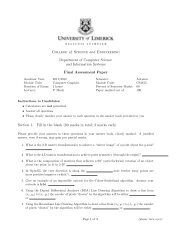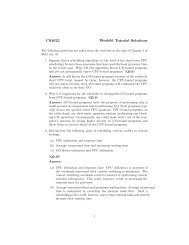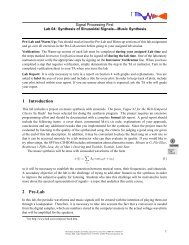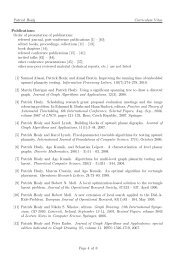FM Synthesis for Musical Instruments - Bells and Clarinets
FM Synthesis for Musical Instruments - Bells and Clarinets
FM Synthesis for Musical Instruments - Bells and Clarinets
Create successful ePaper yourself
Turn your PDF publications into a flip-book with our unique Google optimized e-Paper software.
3.2 Wideb<strong>and</strong> <strong>FM</strong>Using a sampling rate of f s = 8000 Hz, generate a set of wideb<strong>and</strong> <strong>FM</strong> “chirps” with sinusoidal modulationaccording to the <strong>for</strong>mulax(t) = cos(2πf 0 t + B sin(2πf m t))evaluated over the time interval 0 ≤ t ≤ 1.35 secs.(a) First of all, do the case where f 0 = 900 Hz, f m = 3 Hz <strong>and</strong> B = 200. Generate the signal, plot itsspectrogram <strong>and</strong> listen to the signal to see if it corresponds to the spectrogram.(b) Make a sketch (by h<strong>and</strong>) of the instantaneous frequency <strong>for</strong> the signal in part (a).Instructor Verification (separate page)(c) Now, change f m to be f m = 30 Hz <strong>and</strong> B = 20, but keep f 0 = 900 Hz. Generate the signal, plot itsspectrogram <strong>and</strong> listen to the signal.(d) One again, sketch (by h<strong>and</strong>) the instantaneous frequency <strong>for</strong> the signal in part (c) to see if it correspondsto the spectrogram.(e) Now, change f m to be f m = 300 Hz <strong>and</strong> B = 2, but keep f 0 = 900 Hz. Generate the signal, plot itsspectrogram <strong>and</strong> listen to the signal. This is a case of wideb<strong>and</strong> <strong>FM</strong>, <strong>and</strong> the instantaneous frequencyconcept no longer explains the sound we hear, but you should write a reasonable explanation <strong>for</strong> thespectrum that you observe.Instructor Verification (separate page)♥❦❤CD-ROMDemosSpectrogramsWhen unsure about a comm<strong>and</strong>, use help.4 <strong>FM</strong> <strong>Synthesis</strong> of Instrument Sounds4.1 Generating the Bell EnvelopesNow we take the general <strong>FM</strong> synthesis <strong>for</strong>mula (1) <strong>and</strong> specialize <strong>for</strong> the case of a bell sound. The amplitudeenvelope A(t) <strong>and</strong> the modulation index envelope I(t) <strong>for</strong> the bell are both decaying exponentials. That is,they both have the following <strong>for</strong>m:y(t) = e −t/τ (3)where τ is a parameter that controls the decay rate of the exponential. Notice that y(0) = 1 <strong>and</strong> y(τ) = 1/e,so τ is the time it takes a signal of the <strong>for</strong>m (3) to decay to 1/e = 36.8% of its initial value. For this reason,the parameter τ is called the time constant.Use (3) to write a MATLAB function that will generate a decaying exponential to be used later in synthesizinga bell sound. The file header should look like this:function yy = bellenv(tau, dur, fsamp);%BELLENV produces envelope function <strong>for</strong> bell sounds%% usage: yy = bellenv(tau, dur, fsamp);%% where tau = time constantMcClellan, Schafer, <strong>and</strong> Yoder, Signal Processing First, ISBN 0-13-065562-7.Prentice Hall, Upper Saddle River, NJ 07458. c○2003 Pearson Education, Inc.3
% dur = duration of the envelope% fsamp = sampling frequency% returns:% yy = decaying exponential envelope%% note: produces exponential decay <strong>for</strong> positive tauThe function will be one or two lines of MATLAB code. The first line should define your time vector basedon fsamp <strong>and</strong> dur, <strong>and</strong> the second generates the exponential (3).The bell’s amplitude envelope, A(t), <strong>and</strong> modulation index envelope, I(t) are identical, up to a scalefactor.A(t) = A 0 e −t/τ <strong>and</strong> I(t) = I 0 e −t/τHence, one call to the bellenv function will generate the shape <strong>for</strong> both envelopes.4.2 Parameters <strong>for</strong> the BellNow that we have the bell’s amplitude <strong>and</strong> modulation index envelopes, we can create the actual soundsignal <strong>for</strong> the bell by specifying all the parameters in the general <strong>FM</strong> synthesis <strong>for</strong>mula (1). The frequenciesf c <strong>and</strong> f m must be given numerical values. The ratio of carrier to modulating frequency is important increating the sound of a specific instrument. For the bell, a good choice <strong>for</strong> this ratio is 1:2, e.g., f c = 110Hz <strong>and</strong> f m = 220 Hz.Now write a simple M-file bell.m that implements (1) to synthesize a bell sound. Your function shouldcall bellenv.m to generate A(t) = A 0 e −t/τ <strong>and</strong> I(t) = I 0 e −t/τ .function xx = bell(ff, Io, tau, dur, fsamp)%BELL produce a bell sound%% usage: xx = bell(ff, Io, tau, dur, fsamp)%% where: ff = frequency vector (containing fc <strong>and</strong> fm)% Io = scale factor <strong>for</strong> modulation index% tau = decay parameter <strong>for</strong> A(t) <strong>and</strong> I(t)% dur = duration (in sec.) of the output signal% fsamp = sampling rate4.3 The Bell SoundTest your bell( ) function using the parameters of case #1 in the table. Play it with the soundsc()function at 11,025 Hz. 2 Does it sound like a bell? The value of I 0 = 10 <strong>for</strong> scaling the modulation indexenvelope is known to give a distinctive sound. Later on, you can experiment with other values to get a varietyof bells.2 A higher sampling rate of 11,025 Hz is used because the signal contains many harmonics, some of which might alias if a lowerf s were used. You should experiment with lower values of f s to see if you can hear a difference, e.g., f s = 8000 Hz.McClellan, Schafer, <strong>and</strong> Yoder, Signal Processing First, ISBN 0-13-065562-7.Prentice Hall, Upper Saddle River, NJ 07458. c○2003 Pearson Education, Inc.4
CASE f c (Hz) f m (Hz) I 0 τ (sec) T dur (sec) f s (Hz)1 110 220 10 2 6 11,0252 220 440 5 2 6 11,0253 110 220 10 12 3 11,0254 110 220 10 0.3 3 11,0255 250 350 5 2 5 11,0256 250 350 3 1 5 11,025The frequency spectrum of the bell sound is very complicated, but it does consist of spectral lines, whichcan be seen with a spectrogram. Among these frequencies, one spectral line will dominate what we hear.We would call this the note frequency of the bell. It is tempting to guess that the note frequency will beequal to f c , but you will have to experiment to find the true answer. It might be f m , or it might be somethingelse—perhaps the fundamental frequency which is the greatest common divisor of f c <strong>and</strong> f m .For each case in the table, do the following:(a) Listen to the sound by playing it with the soundsc() function.(b) Calculate the fundamental frequency of the “note” being played. Explain how you can verify bylistening that you have the correct fundamental frequency.(c) Describe how you can hear the frequency content changing according to I(t). Plot f i (t) versus t <strong>for</strong>comparison.(d) Display a spectrogram of the signal. Describe how the frequency content changes, <strong>and</strong> how thatchange is related to I(t). Point out the “harmonic” structure of the spectrogram, <strong>and</strong> calculate thefundamental frequency, f 0 .(e) Plot the entire signal <strong>and</strong> compare it to the envelope A(t) generated by bellenv.(f) Plot about 100–200 samples from the middle of the signal <strong>and</strong> explain what you see, especially thefrequency variation.If you are making a lab report, do the plots <strong>for</strong> two cases—choose one of the first four <strong>and</strong> one of thelast two. Write up an explanation only <strong>for</strong> the two that you choose.4.4 Comments about the BellCases #3 <strong>and</strong> #4 are extremes <strong>for</strong> choosing the decay rate τ. In case #3, the wave<strong>for</strong>m does not decay verymuch over the course of three seconds <strong>and</strong> sounds a little like a sum of harmonically related sinusoids. Witha “faster” decay rate, as in case #4, we get a percussion-like sound. Modifying the fundamental frequencyf 0 (determined in part (d) above) should have a noticeable effect on the tone you hear. Try some differentvalues <strong>for</strong> f 0 by changing f c <strong>and</strong> f m , but still in the ratio of 1:2. Describe what you hear.Finally, experiment with different carrier to modulation frequency ratios. For example, in his paper,Chowning uses a fundamental frequency of f 0 = 40 Hz <strong>and</strong> a carrier to modulation frequency ratio of 5:7.Try this <strong>and</strong> a few other values. Which parameters sound “best” to you?5 Optional: C-Major ScaleFinally, synthesize other note frequencies. For example, try to make the C-major scale (defined in Lab 3)consisting of seven consecutive notes.McClellan, Schafer, <strong>and</strong> Yoder, Signal Processing First, ISBN 0-13-065562-7.Prentice Hall, Upper Saddle River, NJ 07458. c○2003 Pearson Education, Inc.5
Lab 05INSTRUCTOR VERIFICATION PAGEFor each verification, be prepared to explain your answer <strong>and</strong> respond to other related questionsthat the lab TA’s or professors might ask. Turn this page in at the end of your lab period.Name:Date of Lab:Part 3.1 Aliasing of the linear <strong>FM</strong> Chirp:Verified:Date/Time:Part 3.2(a),(b) Sinusoidal <strong>FM</strong> Signal Generation:Verified:Date/Time:Part 3.2(e) Explain why the Wideb<strong>and</strong> <strong>FM</strong> Spectrogram has the characteristics that you observe. Does thespectrogram match your “hearing” experience when you listen to the sound in part (e)? Compare your observationsto the spectrogram of other signals that you have seen in the lecture or in the lab. Write a shortexplanation in the space below:Verified:Date/Time:McClellan, Schafer, <strong>and</strong> Yoder, Signal Processing First, ISBN 0-13-065562-7.Prentice Hall, Upper Saddle River, NJ 07458. c○2003 Pearson Education, Inc.6
6 WoodwindsAs an alternative to the bell sounds, this section shows how different parameters in the same <strong>FM</strong> synthesis<strong>for</strong>mula (1) will yield a clarinet sound, or other woodwinds.6.1 Generating the Envelopes <strong>for</strong> WoodwindsThere is a function on the CD-ROM called woodwenv which produces the functions needed to create boththe A(t) <strong>and</strong> I(t) envelopes <strong>for</strong> a clarinet sound. The file header looks like this:♥❦❤CD-ROMwoodwenv.mfunction [y1, y2] = woodwenv(att, sus, rel, fsamp)%WOODWENV produce normalized amplitude <strong>and</strong> modulation index% functions <strong>for</strong> woodwinds%% usage: [y1, y2] = woodwenv(att, sus, rel, fsamp);%% where att = attack TIME% sus = sustain TIME% rel = release TIME% fsamp = sampling frequency (Hz)% returns:% y1 = (NORMALIZED) amplitude envelope% y2 = (NORMALIZED) modulation index envelope%% NOTE: attack is exponential, sustain is constant,% release is exponentialThe outputs from woodwenv are normalized so that the minimum value is zero <strong>and</strong> the max is one. Try thefollowing statements to see what the function produces:fsamp = 8000;Ts = 1/fsamp;tt = delta : Ts : 0.5;[y1, y2] = woodwenv(0.1, 0.35, 0.05, fsamp);subplot(2,1,1), plot(tt,y1), grid onsubplot(2,1,2), plot(tt,y2), grid on6.2 Scaling the Clarinet EnvelopesSince the woodwind envelopes produced by woodwenv range from 0 to 1, some scaling is necessary tomake them useful in the <strong>FM</strong> synthesis equation (1). In this section, we consider the general process of linearre-scaling. If we start with a normalized signal y norm (t) <strong>and</strong> want to produce a new signal whose max isy max <strong>and</strong> whose min is y min , then we must map 1 to y max <strong>and</strong> 0 to y min . Consider the linear mapping:y new (t) = α y norm (t) + β (4)Determine the relationship between α <strong>and</strong> β <strong>and</strong> y max <strong>and</strong> y min , so that the max <strong>and</strong> the min of y new (t) arecorrect.Test this idea in MATLAB by doing the following example (where α = 5 <strong>and</strong> β = 3):McClellan, Schafer, <strong>and</strong> Yoder, Signal Processing First, ISBN 0-13-065562-7.Prentice Hall, Upper Saddle River, NJ 07458. c○2003 Pearson Education, Inc.7
ynorm = 0.5 + 0.5*sin( pi*[0:0.01:1]);subplot(2,1,1), plot(ynorm)alpha = 5; beta = 3;ynew = alpha*ynorm + beta; %
greatest common divisor of the carrier <strong>and</strong> modulating frequencies. For example, when we choose f c = 600Hz <strong>and</strong> f m = 900 Hz, the synthesized signal will have a fundamental frequency of f 0 = 300 Hz.Write a simple M-file clarinet.m that implements the <strong>FM</strong> synthesis equation (1) to synthesize a clarinetnote. Your function should generate the envelopes A(t) <strong>and</strong> I(t) using textttscale <strong>and</strong> textttwoodwenv.The function header should look like this:function yy = clarinet(f0, Aenv, Ienv, dur, fsamp)%CLARINET produce a clarinet note signal%% usage: yy = clarinet(f0, Aenv, Ienv, dur, fsamp)%% where: f0 = note frequency% Aenv = the array holding the A(t) envelope% Ienv = the array holding the I(t) envelope% dur = the amount of time the signal lasts% fsamp = the sampling rate6.5 Experiment with the Clarinet SoundUsing your clarinet( ) function, create a 250 Hz clarinet note with f s = 8000 or 11,025 Hz. Playit with the sound( xnote, fs ) function. Does it sound like a clarinet? How can you verify that itsfundamental frequency is at 250 Hz?Explain how the modulation index I(t) will affect the frequency content versus time of the clarinetsound. Describe how you can hear the frequency content changing according to I(t)? Plot the instantaneousfrequency f i (t) versus t <strong>for</strong> comparison.Plot the entire signal <strong>and</strong> compare it to the amplitude envelope function y1 in Fig. 1. Plot about 100–200samples from the middle of the signal <strong>and</strong> explain what you see.McClellan, Schafer, <strong>and</strong> Yoder, Signal Processing First, ISBN 0-13-065562-7.Prentice Hall, Upper Saddle River, NJ 07458. c○2003 Pearson Education, Inc.9


